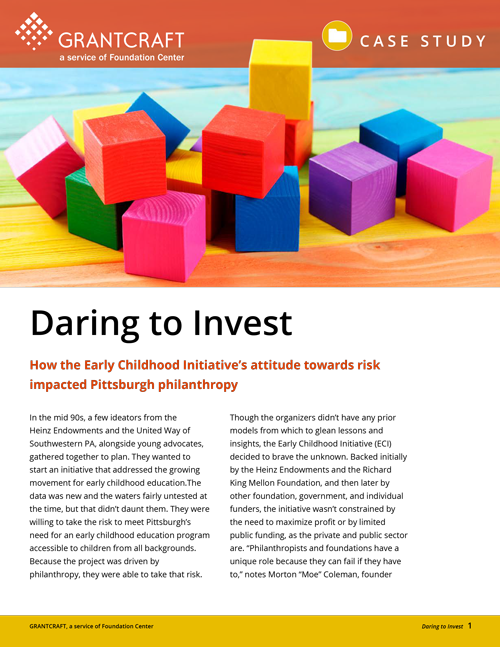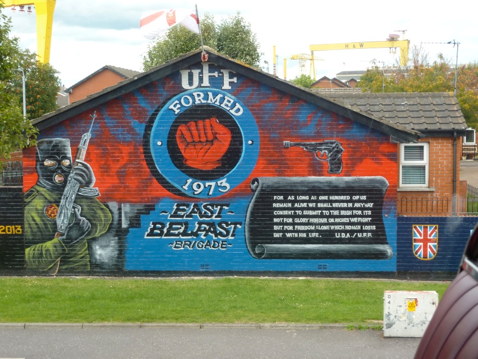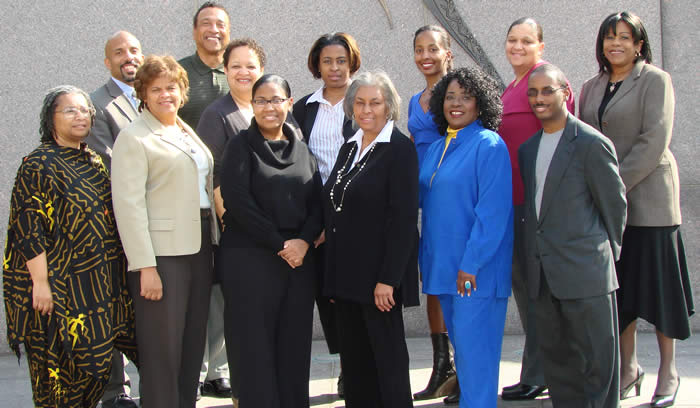Daring to Invest How the Early Childhood Initiative’s attitude towards risk impacted Pittsburgh philanthropy
In the mid 90s, a few ideators from the Heinz Endowments and the United Way of Southwestern PA, alongside young advocates, gathered together to plan. They wanted to start an initiative that addressed the growing movement for early childhood education.The data was new and the waters fairly untested at the time, but that didn’t daunt them. They were willing to take the risk to meet Pittsburgh’s need for an early childhood education program accessible to children from all backgrounds. Because the project was driven by philanthropy, they were able to take that risk.
Though the organizers didn’t have any prior models from which to glean lessons and insights, the Early Childhood Initiative (ECI) decided to brave the unknown. Backed initially by the Heinz Endowments and the Richard King Mellon Foundation, and then later by other foundation, government, and individual funders, the initiative wasn’t constrained by the need to maximize profit or by limited public funding, as the private and public sector are. “Philanthropists and foundations have a unique role because they can fail if they have to,” notes Morton “Moe” Coleman, founder of the Institute of Politics at the University of Pittsburgh. Traditional philanthropy often refuses this mindset, sticking with outcomes-based approaches and requiring evaluatory mechanisms to determine immediate positive impact. This is understandable--who wouldn’t want to know that their dollars are doing good things in the world? Although the data didn’t yet exist, the Heinz Endowments took the risk by spearheading a partnership with the United Way of Allegheny County and the Office of Child Development at the University of Pittsburgh.“Resources invested in a project that may or may not yield outcomes that we desire should be carefully considered,” notes Saleem Ghubril, executive director of The Pittsburgh Promise. Yet philanthropic dollars’ flexibility also allow it to act “a bit like research and development for the public sector,” says Gregg Behr, executive director of the Grable Foundation. “Philanthropy stands in the position to help organizations, schools, or whichever public entities might want to experiment constructively and positively based on some promising evidence.”
Philanthropy, notes Gregg, is partially about “being really curious, trying to weave your way through early data and early success, and placing bets. It’s much easier to support something when you have a randomized control study that shows what you can expect. It’s a lot harder when you just have some early yet promising findings.” ECI was one such bet that was still in the early stages of evidence gathering and model design, but which grantmakers and other allies hypothesized would have a positive impact; they decided to embrace the risk. After more than a year of planning, the initiative began, with the goal of reaching 7,600 kids by the end of five years. As time progressed, however, leadership realized the program wasn’t going to come close to meeting that target, and so ECI transitioned from a full scale program to a demonstration program in 2001.
In moving away from its original manifestation, ECI embodied another element of risk taking: cutting your losses. Gregg acknowledges that “sometimes organizations fall apart” and he believes that when that occurs “people have to have the freedom to pull that cord and stop what’s happening.” Acknowledging when something isn’t working and taking action to right that, whether it be dismantling a project and learning from the process or iterating on how a project functions, is a necessary component of practicing risk.
By evaluative standards, ECI was a “failure,” yet the Heinz Endowments used the dismantling of ECI to comprehensively investigate why ECI had not produced the expected results. “It took that failure, analyzed it, and wrote a very strong evaluation,” remembers Moe. It also made the resulting RAND report available to others so that future programs could learn from the work of ECI. Moe advocates for this method of evaluation and iteration. “If a project doesn’t work, just don’t throw it in the garbage can but say ‘let’s figure out why it didn’t work and let’s see if we can learn how we can do things better in the future.

The Early Childhood Initiative focused on making early childhood education more accessible to at-risk children. While the initiative ended in 2001, the lessons learned have informed programs with similar missions.
One lesson in particular has stayed with the early childhood community of Pittsburgh since ECI. As Coleman puts it, “you can’t eliminate what’s on the ground, you’ve got to in some way absorb that into the process.” ECI strove to implement a new program without fully taking into account the existing community infrastructure. This mistake has been noted since the RAND report’s release and has shifted the mentality about a foundation’s role in the community. “It’s important for those of us working in foundations to be out of our office as much as possible, to be present to the community and in a way that we’re really listening, we’re observing, we’re witnessing,” Gregg shares. Gaining firsthand knowledge of the work organizations are doing, as well as the needs and structures present in the community, and then factoring that into program design can strengthen grantmaking decisions and inform what type of grant to give.
ECI was a risk that had unexpected results, but one that the philanthropic leaders of Pittsburgh stand by. “There are certain times and certain projects that we will never see produce the outcomes we desire without daring investment,” notes Saleem. The learnings gained from ECI have had a poignant impact on the early childhood education community of Pittsburgh. Grow up Great, a program started in the wake of ECI, has distributed over $70 million in grants and over two million children and at-risk preschoolers have participated. Gregg shares, “that initial investment and the research to understand what worked well and what didn’t work so well is an example of an innovation in philanthropy that stands as a model for so many other early childhood investments.” That innovation is what can be achieved by daring to invest.
At Grable, they believe that grantmaking discussions should be a negotiation, as both parties have important insight into the decision and fostering trust allows for greater comfort in taking risks. “The organizations we support are on the ground level every day dealing with all sorts of challenges. Grable complements that with a broader lensed approach and the ability to see how connections might be made and how systems work,” explains Gregg. Relationships are built upon a foundation of trust between partners, and Gregg notes that the ability to have candid conversations about money is a key element in creating such comfort to the degree that grantees are even allowed to “direct their own risks.”One way that Grable empowers grantee risk taking is through general operating support grants. “Especially when organizations have a track record of success and past evidence of results, why not give people the freedom of general operating support or unrestricted programmatic support to do what they know to do really well?” Gregg asks.
So if risk taking can lead to so many positive results, what stops grantmakers from embracing it wholeheartedly? “Evaluation,” answers Gregg, “There are some cases where the pendulum has swung so far that there’s an expectation of certain results at certain times, as if one were measuring profits and sales of a particular product.” Gregg wants to challenge this blanket drive for evaluation, “Are we evaluating to learn and iterate and improve?” he asks, “Or are we evaluating for merely and solely purposes of accountability?”
Shifting the centrality of evaluation must include people from all levels of a foundation. Gregg shares that Grable works to shift the centrality of evaluation by having “very genuine conversations with our trustees.” When giving a grant and determining what sort of evaluation mechanism to put in place the staff asks themselves: “What’s fair to evaluate? In what types of cases are we fooling ourselves to think that we’re going to get the types of results based on the types of investments and grants we are able to award? Where does other research, by necessity, need to stand as a proxy? If we do demand certain results, are we willing to invest the amount of money necessary to do the social science and to support the staffing to accomplish that?” This type of self interrogation process, coupled with an open discussion with the grantee about what they need and what they think is fair to ask for given the input can strengthen the grantmaking relationship and illuminate places where risk taking may be beneficial.
The unknown is uncomfortable, and these types of discussions are not commonly integrated into philanthropic practice. But when leadership is able to “embrace creative tension” as Gregg puts it--that “messiness” of not knowing how something is going to turn out--that is where Gregg believes “you might end up having the biggest successes.”
This case study was developed as one of five companion pieces to stories shared through the Pittsburgh Philanthropy Project. The Pittsburgh Philanthropy Project, in association with the University of Pittsburgh, showcases the rich and varied narratives of giving in the region through comprehensive storytelling techniques, giving insight to the philanthropy landscape and approach for residents, researchers, and practitioners. Please visit http://storyline.gspia.pitt.edu to explore, and check back soon to the “Related Resources” content for other case studies in this series.






